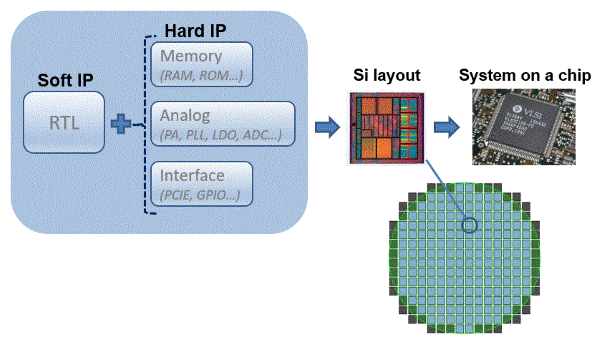ip2soc.com
Engage and we Empower you to Excel!

Our service offering:
-
Data driven personalized medical devices.
-
Support IP developers in design simulations.
-
Specialized training in IC design methodology.
-
Support the customer in the SoC design flow.
-
Engagement with foundry partners for test-chip development.
-
Standard cell, IO and memory characterization.
News!
-
We have signed an agreement with TowerJazz foundry for designing test-chips using their IP!
-
Technologies enabled : 130nm, 180nm and 300nm RFCMOS processes.
ASIC design training
Our state of the art training sessions have been created with one goal in mind; providing people with an affordable, user-friendly learning platform. On-site projects and tutorials are intended to provide the users with a flavor of the work involved in the semiconductor design industry and an opportunity to learn new skills.
This session will include some examples of logic synthesis, standard cell library offering, library views used by CAD tools: layout, LEF, library characterization following by verification.
Static Random Access Memory : SRAM
This session will cover memory classification, SRAM bitcell, stability, read/write in SRAM, timing in SRAM, memory compiler, layout etc...
Dynamic Random Access Memory : DDR memories (under development)
This session will cover memory classification, DRAM bitcell, read/write operation in DRAM, read/write timing in asynchronous DRAM, JEDEC standard for refresh, DRAM subsystem organization, SDRAM, DDR memory interface, synchronization, custom layout, training modes etc...
This session will cover the essentials of Static timing analysis, False paths, Multi-cycle paths, Half-cycle path, lock-up latches, run complexities in STA : CDC, OCV, SI, MMMC etc...
This session will cover the basics of SoC design flow : Design import, MMMC, Extraction, Floorplan, Placement, Clock tree synthesis (CTS), routing, sign-off to finished design.
This session will cover the basics of IC layout essentials. : Placement of well and substrate taps, shielding of critical nets, antenna fixes, DFM, ERC compliance, power grid and de-coupling capacitors, diodes attached to input pins, double patterning, common centroid layout etc...
Projects :
1. Design, implementation and analysis of linear feedback shift register circuits.
2. 8-bit signed binary multiplier : design and analysis (booth multiplier included).
3. Design and implementation of a 8-bit floating point adder.
4. Design and implementation of a multicycle MIPS processor.
5. Implementation of 7-tap linear phase FIR (Finite impulse response) digital filters. (under development)
ip2soc.com
STDCELL CONTENTS
Logic synthesis: Synthesizing a design using standard cell foundation IP.
Synthesized gate level logic : FSM -> RTL -> Netlist
Standard cells like LEGO blocks.
Typical standard cell offering.
Voltage domain crossing : Level shifter cells.
Power gating cells for collapsible domains.
Clock gating cells : Dynamic power mitigation.
Clock domain crossing (CDC) cells.
Files in a library (.v, .lef, .gds2, .sp, .lib, .cdev, .spcurrent).
CMOS Inverter layout.
Layout versus abstract view.
Behavioral Verilog models.
Physical views : gds2 and lef.
Spice netlist.
Liberty models.
Redhawk models.
Standard cell Characterization : NLDM versus CCS.
Standard cell verification : Spice versus verilog versus .lib.
Thank you!
SRAM memories
Memory classification : Non-volatile (ROM) and volatile (SRAM, DRAM) memories.
Memory organization.
6T SRAM versus 1T-1C DRAM bitcell.
Write operation in a 6T SRAM bit-cell array.
Sense-amplifier in SRAM.
Read operation in a 6T SRAM bit-cell array.
Stability of 6T SRAM bit-cell : Static noise margin.
Access time components in an SRAM.
Reducing access time. C∆V/I (architecting the memory)
Cycle time : Read after a write.
Replica based self-timing.
Memory leakage mitigation (80 nW/bit?) : Standby, retention and sleep modes.
Half selected bit-cell.
Read/write assist techniques.
Redundancy and error correction.
Memory compiler and layout.
π3 modeling
Memory Characterization.
Memory testing : Embedded BIST
Thank you!
STA CONTENTS
Motivation for static timing analysis.
Inputs/Outputs : STA tool.
Different timing paths in STA.
Register to register path : PT commands/reports.
Input IO to register path : PT commands/timing report.
Register to output IO path : PT commands/timing report.
Input IO to output IO path : command/timing report.
False path/Multi-cycle path/Half cycle path.
Lock-up latches : scan chains.
Run complexity of STA.
MMMC : Multi-mode multi-corner analysis.
MMMC Primetime commands.
Extraction corners : Cmin, Cmax, Ctyp, RCmin, Rcworst.
OCV : Max analysis.
OCV : Min analysis.
SI : Timing windows.
OCV + SI : Effect of Xtalk - Max. analysis.
OCV + SI : Effect of Xtalk - Min. analysis.
Example (rtl2gds) : Sequence detector.
Thank you!
SOC CONTENTS
Physical design flow.
CAD tools.
MMMC: Multi-mode multi-corner analysis.
MMMC tcl commands.
Extraction corners : Cmin, Cmax, Ctyp, RCmin, Rcworst.
Floorplan.
Placement goals.
Simplistic placement : Minimize ‘virtual net length’ - HPWL.
CTS objectives.
Clock tree routing.
Routing.
Maze algorithm.
Sign-off : DRC, LVS, ERC, Density, Antenna, EM-IR, DFM, STA, ATPG, Equivalency.
Antenna violation.
Antenna fix.
DFM violations : Yield enhancement fixes.
Thank you!
IC LAYOUT
FinFet versus CMOS.
Layout of a differential amplifier : Common centroid layout.
Standard cell layout.
Double patterning and variability.
Antenna fixes.
DFM : Yield enhancement techniques.
Shielding of critical nets.
Placement of well and substrate taps : Latch-up concerns.
Input clamping : Reverse biased diodes attached to input pins.
Power grid planning (de-coupling capacitors attached to grid).
ERC compliance : Level shifter example.
OPC : Optical proximity correction.
WPE : Well proximity effect.
Thank you!
...